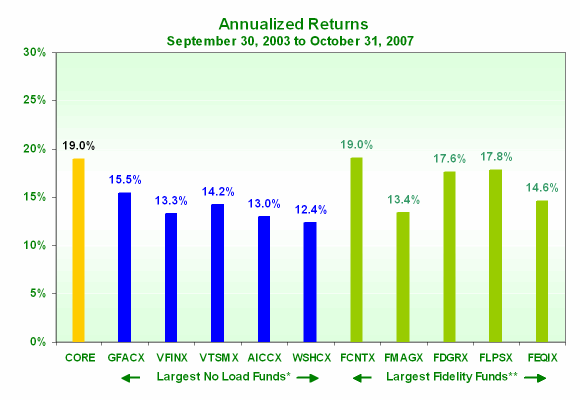Subscribers tracking the AlphaProfit Core model portfolio since inception in September 2003 more than doubled their investment account this October.
The Core model portfolio is an alternative to diversified domestic mutual funds for many subscribers. We compare its performance with that of the five largest no-load domestic mutual funds and Fidelity’s five largest domestic funds.
AlphaProfit Core has compounded at an average annualized rate of 19.0% since inception on September 30, 2003 to October 31, 2007. During this period, the above universe of large domestic mutual funds has on average gained at 15.1%. The Core model portfolio outperformed the titans by 3.9% per year yielding $1,950 more annually on a $50,000 investment.
Mutual fund investors often worry about changes in fund management affecting returns. The Core model portfolio makes it less of an issue by using a consistent strategy to select sectors and industry groups based on their valuation, momentum, and news quality.

** The five largest Fidelity funds in the domestic category are Fidelity Contrafund (FCNTX), Fidelity Magellan (FMAGX), Fidelity Growth Company (FDGRX), Fidelity Low Priced Stock (FLPSX), and Fidelity Equity Income (FEQIX).
* The five largest no-load domestic funds are Growth Fund of America Class C (GFACX), Vanguard 500 Index (VFINX), Vanguard Total Stock Market Index, (VTSMX), American Funds Investment Company of America Class C (AICCX), and American Funds Washington Mutual Investors Class C (WSHCX).
Source: Mutual fund data from Morningstar
Here are some additional points worth noting about the Core model portfolio:
- The portfolio seeks to outperform the broad averages by using favorably ranked sectors and industry groups while leaving out unfavorably ranked ones.
- The portfolio strives to balance return, diversification, and tax efficiency.
For many investors, the Core model portfolio tends to be a worthy choice for their Rollover IRAs.

 Sick buying high & selling low? Fed up of the fees you pay? Tired researching investments? End your financial pain now. You have the opportunity to
Sick buying high & selling low? Fed up of the fees you pay? Tired researching investments? End your financial pain now. You have the opportunity to 

 DEC. 1993 to DEC. 2023
DEC. 1993 to DEC. 2023





